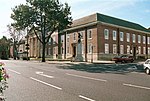Worthing

Worthing () is a seaside resort town in West Sussex, England, at the foot of the South Downs, 11 miles (18 km) west of Brighton, and 18 miles (29 km) east of Chichester. With a population of 113,094 and an area of 12.5 square miles (32.4 km2), the borough is the second largest component of the Brighton and Hove built-up area, the 15th most populous urban area in the United Kingdom. Since 2010, northern parts of the borough, including the Worthing Downland Estate, have formed part of the South Downs National Park. In 2019, the Art Deco Worthing Pier was dubbed the best in Britain.Lying within the borough, the Iron Age hill fort of Cissbury Ring is one of Britain's largest. The recorded history of Worthing began with the Domesday Book. It is historically part of Sussex in the rape of Bramber; Goring, which forms part of the rape of Arundel, was incorporated in 1929. Worthing was a small mackerel fishing hamlet for many centuries until, in the late 18th century, it developed into an elegant Georgian seaside resort and attracted the well-known and wealthy of the day. In the 19th and 20th centuries, the area was one of Britain's chief market gardening centres.Modern Worthing has a large service industry, particularly in financial services. It has three theatres and one of Britain's oldest cinemas, the Dome. Writers Oscar Wilde and Harold Pinter lived and worked in the town.
Excerpt from the Wikipedia article Worthing (License: CC BY-SA 3.0, Authors, Images).Worthing
Chapel Road,
Geographical coordinates (GPS) Address Nearby Places Show on map
Geographical coordinates (GPS)
| Latitude | Longitude |
|---|---|
| N 50.814722222222 ° | E -0.37138888888889 ° |
Address
Chapel Road
Chapel Road
BN11 1BG
England, United Kingdom
Open on Google Maps









